Review: Casino Royale
“The coldest blood runs through my veins,
You know my name”
Chris Cornell
So sings Chris Cornell in the lackluster theme song to Casino Royale, the latest film in the James Bond franchise. Now pay attention, because you have already heard one of my only complaints about the entire movie and there won’t be many more. After decades of the series creaking along using the same tired tricks, EON Productions has started over again, right where they should have – not with the first movie, but with the first book.
* SPOILERS *

Ian Fleming’s Casino Royale (1953) was the slim introduction of Her Majesty’s Secret Agent 007, though it was far less of of an “origin” story than is being expoused elsewhere. When we first meet Bond, he is already a double-O agent. The two kills required for that status are mentioned, but not actually described until later in the series. In fact, most of Bond’s background is fleshed-out in other books. Instead, Fleming’s Casino Royale is a spare portrait of Bond at a turning point in his life. From the novel:
“But he was honest enough to admit that he had never been made to suffer by cards or by women. One day, and he accepted the fact, he would be brought to his knees by luck or by love. When that happened he knew that he too would be branded with the deadly question-mark he recognized so often in others, the promise to pay before you have lost: the acceptance of fallibility.”
And when Bond does fall in love with Vesper Lynd, he is brought to his knees…in spades. [Heh, sorry about that one.] It’s this story – the story of a fallible…broken Bond that the producers have brought to the screen this time.
It should be noted that there were two earlier Casino Royale films. The first was as a 1954 CBS Climax Mystery Theater teleplay (filmed before a live studio audience), starring Barry Nelson as CIA agent Jimmy Bond and Peter Lorre as the criminal LeChiffre. The second was a 1967 motion picture, starring Woody Allen, David Niven, and Peter Sellers (among others) as James Bond. Yes, you read that correctly. It was an unwatchable psychedelic mess. Neither production is accepted canon and the less said about them, the better.
Martin Cambell returns to the director’s chair and brings along the writers of the last two Bond films Neal Purvis, Robert Wade, now with some help from Academy Award winner Paul Haggis (Million Dollar Baby, Crash). Cambell directed Goldeneye, Pierce Brosnan’s entry into the series and one of the better modern Bond films.
The plot of Casino Royale follows it’s respective novel more closely than perhaps any other Bond film. LaChiffre, banker to Ugandan terrorists, has lost their money in a foiled stock market fraud and he plans to win it back in a high-stakes poker game at the Casino Royale in Montenegro, before he can be killed by his disgruntled investors. Bond’s mission is to defeat him in the poker game. Sound thin? It is, but Bond stories aren’t about the plot, they are about…Bond.
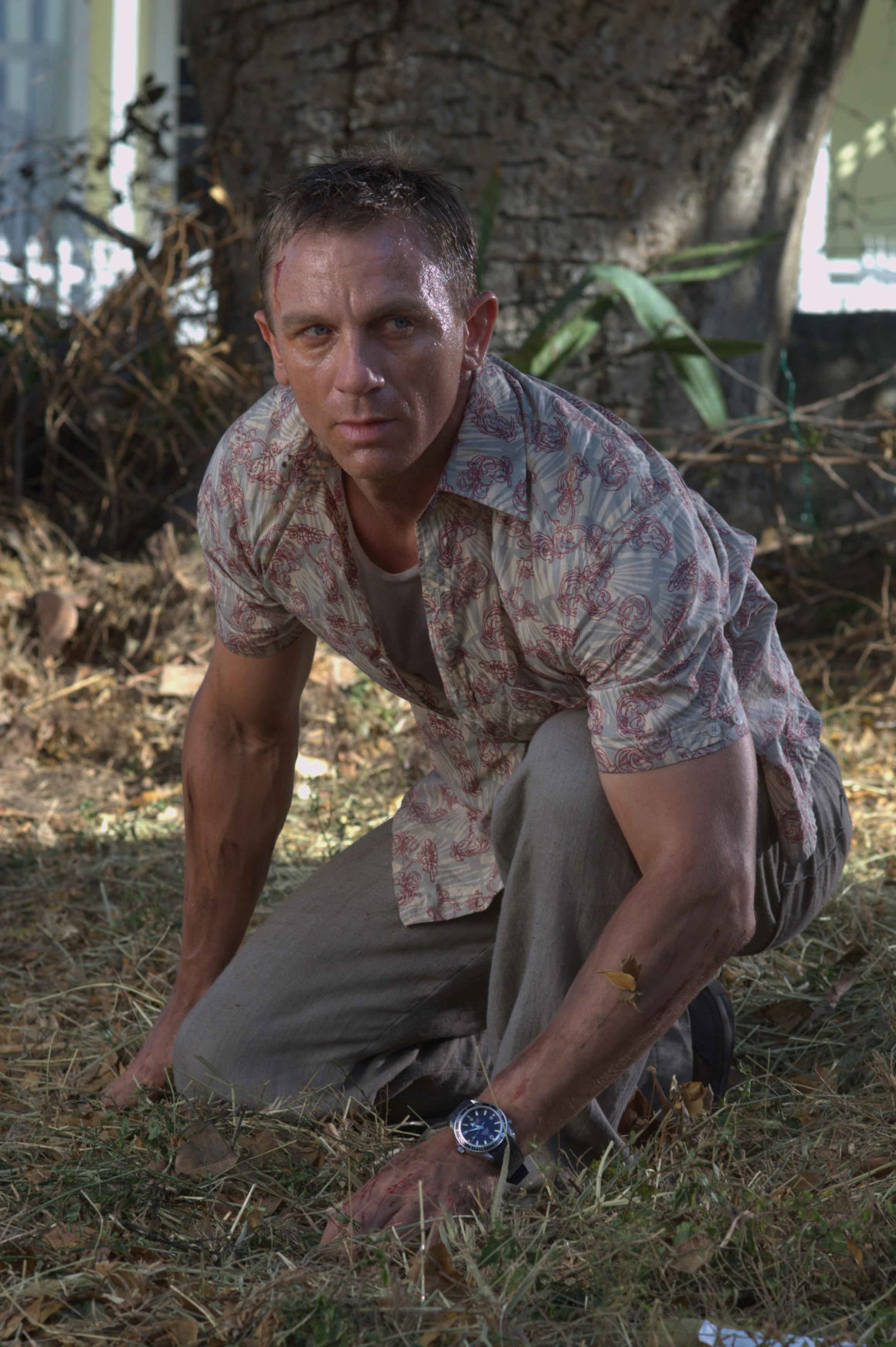
Let’s get this out of the way. Daniel Craig IS James Bond. There was a firestorm of early criticism and doubt about Craig’s looks. He doesn’t fit the classic tall, dark, and handsome Bond. He is short, pale, and…um, not conventionally handsome. And of course, he has blond hair. I admit that I was also taken aback at this. How could they make James Bond blond? In over 40 years of making Bond films, they couldn’t even be bothered to make Felix Leiter (Bond’s friend and CIA counterpart) blond. At least eight actors have played the part and not one “straw-haired Texan” (as Ian Fleming describes Leiter).

Craig appeared on screen and I never once thought about the color of his hair. His ownership of the role (along with the pre-credit sequence being filmed entirely in black and white) rendered the silly concern for his hair color moot. And though he is the shortest Bond (though not really all that short and certainly not Tom Cruise short), Craig is built like a boxer and is the first Bond since the 60’s who looks like he has the physicality to do the superhuman things that we expect from 007. It’s fitting and just a bit cheeky that for this reboot of the series, they took one of the most iconic scenes in all of the Bond films, that of original Bond-girl Ursula Andress wading out of the ocean in Dr. No and stood it on it’s head by instead having Craig wade out of the ocean in a skimpy swimsuit.

Craig plays Bond as a blunt instrument. He grunts, he vomits, he sweats, he bleeds. He kills with his bare hands. Bond is still sophisticated, but one gets the feeling that unlike earlier Bonds, this 007 can’t sniff-out an “overdose of Bons Bois” in an indifferently blended brandy (Goldfinger). In a harsh send-up of those who have come before, Bond orders a martini and when asked by the bartender “Shaken or stirred?”, Bond spits back, “Do I look like I give a damn?” Bond behaves like a man who knows he is living on borrowed time and when he is finally brought to the edge of death in a raw, humiliating torture scene that strips Bond of any possible arrogance, pride, even manhood, our new Bond does not sit back and coolly activate a Q-Branch gadget on his wristwatch, a deus ex machina to save the day. Instead, Bond cries out like an animal in blood-curdling anguish and then says what he has to say to bring his death quickly. Bond is beaten. This is new ground, indeed.

Also new is a Bond-girl that finally works. Eva Green is absolutely radiant as Vesper Lynd, a government accountant sent to oversee the funding of Bond in the high-stakes poker game at Casino Royale. When she first meets Bond, she goes toe-to-toe with him, showing-off her quick wit, intelligence, confidence, and lest we think her just a nerdy bean-counter, her sexual assertiveness, with a comment about keeping her eye on the government’s money and off of Bond’s “perfectly formed ass.” As a nit-picky aside, when she meets Bond for the first time, he is seated and remains seated until she leaves their dinner. So just how did she know he had a perfectly formed ass? Is it in his dossier? Hair: blond, Eyes: blue, Ass: perfectly-formed. Yeah, that’s what my dossier says, too.
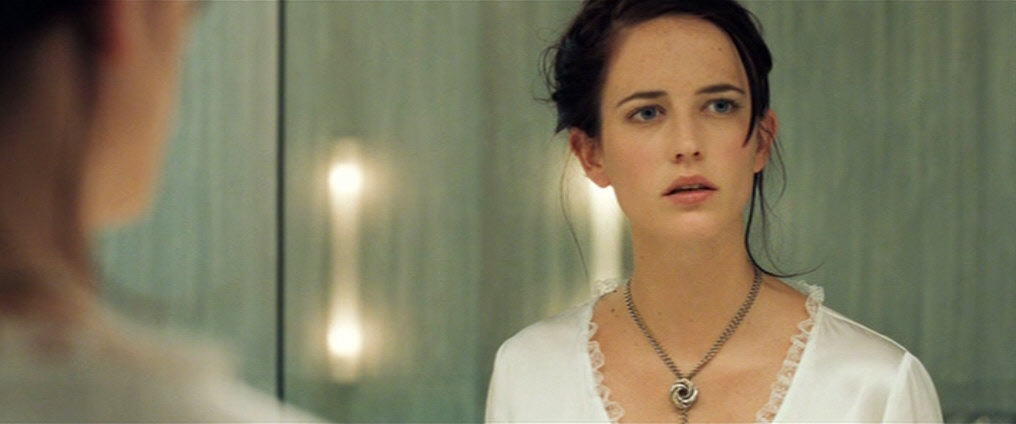
Vesper talks tough, but when the game goes from poker to hardball, we see her outer layers start to peel away. In one of the most brilliant moments in the film, we see what almost looks like a domestic scene as Bond and Vesper are dressing for the first evening at the casino. Bond walks into Vesper’s bathroom and tells her to wear a dress that will draw attention to herself. Vesper counters by telling Bond that she has bought him a new dinner jacket, because his wasn’t suitabe for such a high-class affair. Ouch. But then we see her face reflected in the mirror. She isn’t wearing any makeup and she looks softer and younger than before. She is looking back at Bond, a tuxedo covered razor blade, and there seems to be a hint of doubt around her eyes, perhaps a realization that she is about to be in over her head. By the end of the evening, for the first time ever, we see a Bond-girl that is utterly disturbed about being in such close proximity to the cold violence of Bond’s world. It’s this vulnerability that warms us to Vesper, just as it does Bond.
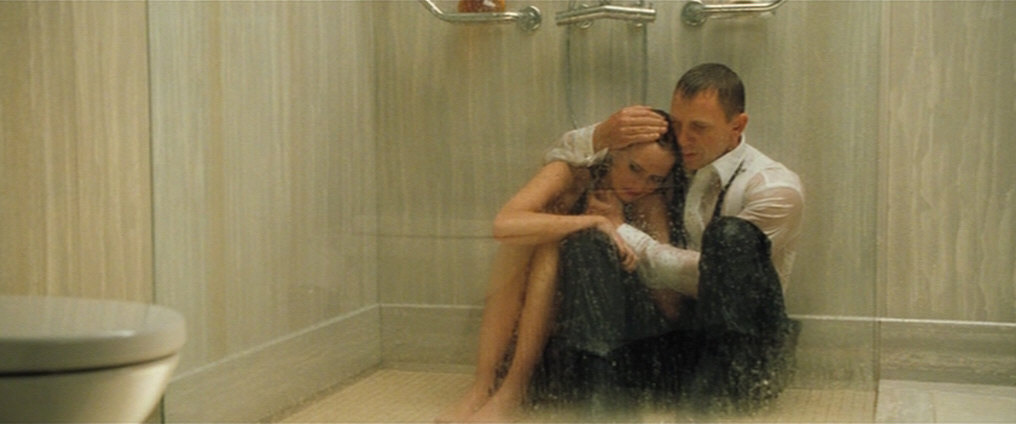
Still, despite the added depth of character and other more superficial changes (mostly for the good), the Bond formula is alive and well. The Bond franchise is worth hundreds of millions of dollars and the old guard would never allow it to begin again from a blank sheet of paper. Let’s run down some of the elements of the Bond formula and see how they fared:
The Pre-Credit Sequence

Say, where is the gunbarrel shot? You can’t tell me anything was wrong with that! More serious and less thrilling than most, we see Bond earning his license to kill, first in a brutal fight and then quietly, in cold blood, all rendered in beautiful black and white photography. This is a stark announcement that things will be different. The gunbarrel shot comes at the end and the more traditional action-packed pre-credit sequence is queued after the title sequence.
Title Sequence and Theme
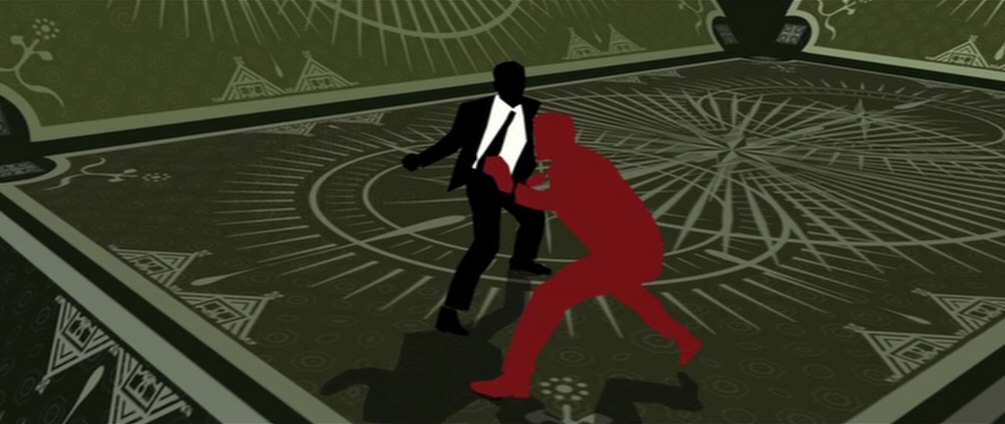
The title sequence also gets a new animated look, but misses the mark. The playing card theme gets tired quickly and when Daniel Craig finally appears in sillhouette, it looks too much like they are riffing on the iPod ads (which by the way, look to me like riffs on the 30 years of classic 007 title sequences done by Maurice Binder.) While I don’t think we need to go back to the Freudian-heavy title sequences such as the one for Thunderball (with it’s scuba divers pursuing naked sea-nymphs and shooting at them with their…um, spears), they were at least fun in their outrageousness. The new title sequence contains no female figures and worse, no humor. It doesn’t help that over this sequence is played the aforementioned theme song which apparently is so bad, that it isn’t even included on the soundtrack album. For a change of pace, I would have liked to have seen a title sequence like that done by Kyle Cooper for the recent film Kiss, Kiss, Bang, Bang (the title which, for those who don’t know, is a reference to James Bond.)
Bond Girls

There are just two. Vesper Lynd and another woman with whom Bond has a brief, unconsummated fling, strictly for queen and country. There are still the female hotel clerks whose eyes make open invitations to Bond and it is with this convention that I take issue. I don’t think our new man is up to this. For example, in one scene, Bond drives up to the front of a resort in the Bahamas, gets out of his car, and two women walk past him, look him up and down, and share a lascivious giggle. Admittedly, this is classic Bond. But this isn’t the Ur-Bond, Sean Connery stepping out of his 1964 Aston Martin DB5, nor even the handsome Pierce Brosnan stepping out of his Vanquish in a beautiful Brioni suit. No, it was a somewhat jug-eared man who looked like his face had been beaten repeatedly with a potato masher, wearing ordinary clothes, stepping out of (I kid you not) – a Ford Mondeo rental car! In fact, less than 30 seconds later, Bond is mistaken for a valet. Now that I believe.
The Villians
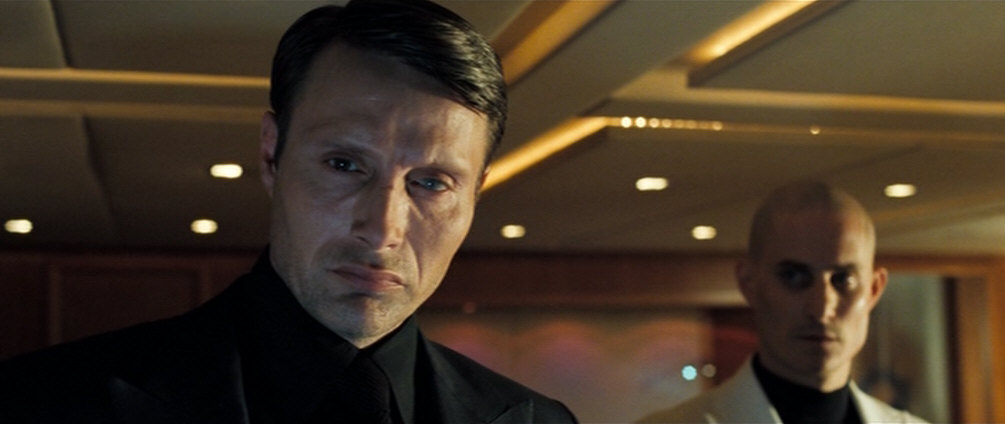
Never were there a bunch of more ordinary thugs. Criminal and cruel, yes, but as LeChiffre (Mads Mikkelsen) explains to a business partner about his eye that weeps blood, “…it is a (damaged) tear duct…there is nothing sinister about it.” And so there isn’t. Le Chiffre is not a megalomaniac with a bonkers plan to destroy the world, but rather an investment banker just trying to get back some money that he lost short-selling some stocks. Nothing more. In fact, until Bond involves himself in LeChiffre’s affairs, the only person in danger of being killed is LeChiffre himself. There are terrorists, henchmen, and a bomb-maker that can run and jump over stuff, but they are otherwise rather ordinary. No scary names or superhuman abilities. This is good.
Q-Branch
There is no Q and there are no Q-Branch gadgets in Casino Royale. None. For now, this is also a good thing. It lets us see Bond have to use perhaps his single best attribute – his resourcefulness. In one scene, we see Bond break into a security office using nothing more than a simple distraction. In another, Bond is caught without a weapon and instead of reaching for an infallible Q-Branch gadget, he snatches-up a table knife and strides towards his quarry. This kind of simplicity serves Bond’s character well.
Other classic Bond elements like Exotic Locations, egregious Product Placement, Fast Cars, and Drinking (lots of drinking in this film) are all present. There is less humor than in most other Bond films, but we still get to see Bond enjoying himself once in awhile and there are still a few quips and double-entendres, though thankfully no real groaners.

Casino Royale might be the best introduction of a new James Bond ever. Yes James, we know your name, but now, we’ve got your number. Welcome back.

02.25.2020: I really like the Chris Cornell song now. I just needed to give it some time.
Please pin, tweet, and share! Most importantly, let me know what you think in the comments below.











2 comments
This is one of the best movie reviews I have ever read. Nicely done.
You always thought you were James Bond. Nice to see things haven’t changed.